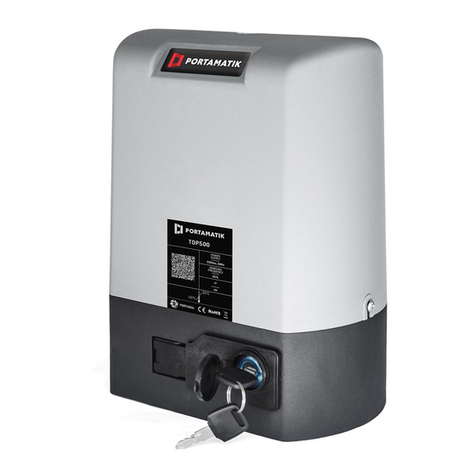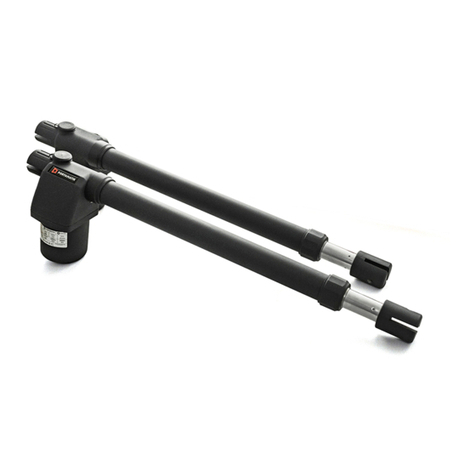
2
SAFETY INSTRUCTIONS
In order for the automation system to function
properly, the following parameters must be careful
before installation:
Read all the steps at least once so that you know
the installation and configuration process.
Make sure that the door frame is solid and in condi-
tion to be automated.
Check that the sectioned door has no mechanical
faults, such as friction / locking points, as this may
jeopardize the durability of the operator.
Make sure the door is in good condition to install
the motor. To do this, raise it manually at 800mm,
1600mm and 2000mm off the ground.
Make sure that the door stays suspended in these
positions or to lower it minimally. If the door starts
to rise or fall, it means that the springs are not well
calibrated.
Check the surrounding space. Carefully evaluate
any hazards that could cause property damage,
may possible contact with insects, infiltrations, and
so on.
Make sure that the drive is plugged into a pro-
perly grounded 230V outlet.
Check for proper electrical protection against short
circuits / current peaks, and ground connection on
the Electrical Board.
Be careful in the event that you directly handle the
control unit. Incorrect handling may damage some
electrical components.
Make sure you have prepared all the necessary
material for the installation.
Evaluate the security devices to install. This will
ensure that unexpected accidents do not happen.
To ensure full operation of the operator, check that
the door frame is strong enough.
CONTENT
It is very important that these precautions are
adhered to!
Only in this way can the correct operation and dura-
bility of the operator be assured!
PRE-INSTALLATION
PRE-INSTALLATION...............................................................................
PACKAGE................................................................................................
OPERADOR............................................................................................
MANUAL BRAKE RELEASE.................................................................
REMOVING TOP COVER....................................................................
SWITCH LAMP 24V 5W......................................................................
REPLACE FUSE..................................................................................
INSTALLATION........................................................................................
FIXING THE MOTOR IN RAILS...........................................................
FIXING OF THE SUPPORT PLATE.....................................................
AUTOMATISM INSTALLATION............................................................
INSTALLATION MAP............................................................................
PROGRAMMING.....................................................................................
MENU FUNCTIONS.............................................................................
PROGRAMMING OPENING AND CLOSING COURSES............
PROGRAMMING OF THE AUTOMATISM FORCE LEVEL.................
ENABLE/DISABLE SAFETY PHOTOCELLS.......................................
PROGRAMMING THE SELF-CLOSING FEATURE......................
ENABLE/DISABLE CONDOMINIUM FUNCTION...............................
PROGRAMMING MAINTENANCE WARNINGS..................................
PROGRAMMING REMOTE CONTROLS................................................
STANDARDCONFIGURATION............................................................
CONFIGURATION THROUGH ALREADY CONFIGURED CONTROL
DELETE ALL CONFIGURED REMOTE CONTROLS..........................
POST- INSTALLATION.............................................................................
STOPPER AT THE OPENING............................................................
STRETCH RAIL’S CHAIN....................................................................
MAINTENANCE.......................................................................................
DIAGNOSIS...........................................................................................
TROUBLESHOOTING...........................................................................
CENTRAL CONNECTIONS..................................................................
2
3
3
3
4
4
4
4
4
5
5
6
7
7
7
7
7
8
8
8
8
8
8
9
9
9
9
9
10
11
13
• It is important for your safety that these instructions
are followed.
• Keep these instructions in a safe place for future re-
ference.
• The Supplier is not responsible for the improper use
of the product, or other use than that for which it was
designed.
cal wires, essentially on the power cable.
• When programming the control unit, pay particular
attention to touching only the location intended for that
purpose. Failure to do so may result in electric shock.
• The Supplier is not responsible if safety standards
were not taken into account when installing the equip-
ment, or for any deformation that may occur.
• The Supplier is not responsible for insecurity and mal-
function of the product when used with components
that were not sold by the them.
• This product was designed and manufactured strictly
for the use indicated in this manual.
• Any other use not expressly indicated may damage
the product and/or can cause physical and property
damages, and will void the warranty.
• Do not make any changes to the automation compo-
nents and/or their accessories.
• Keep remote controls away from children, to prevent
the automated system from being activated involunta-
rily.
• The customer shall not, under any circumstances, at-
tempt to repair or tune the operator. Must call qualified
technician only.
• The installer must have certified professional knowle-
dge at the level of mechanical assemblies in doors and
gates and control board programmation. He should
also be able to perform electrical connections in com-
pliance with all applicable regulations.
• The installer should inform the customer how to han-
dle the product in an emergency and provide him the
manual.
• This device can be used by children 8 year old or older
and persons whose physical, sensory or mental capa-
cities are reduced, or by persons without experience
or knowledge if they have received supervision or ins-
tructions on the use of the device in a safe manner and
understood the hazards involved. Children should not
play with the device. Cleaning and maintenance by the
user must not be carried out by unsupervised children.
• Before installing, the installer must verify that the tem-
perature range indicated on the operator is appropriate
to the location of the installation.
• Before installing, the installer must verify that the
equipment to be automated is in good mechanical
condition, correctly balanced and opens and closes
properly.
• If the operator is to be installed at a level higher than
2,5 m above ground level or other level of access, ,
should be followed the minimum safety and health re-
quirements for the use of work equipment workers at
work in Directive 2009/104/EC of the European Parlia-
ment and of the Council of 16th September of 2009.
• In the case of the equipment where the automation
will be installed, have a pedestrian door, be aware that
it must be closed when the operator is activated.
• After installation, make sure that the mechanism is
properly adjusted and that the protection system and
any manual unlocker works correctly.
• In order to protect the electrical cables against me-
chanical stress, you should use conduit for the electri-
This product is certified in accordance with
European Community (EC) safety stan-
dards.
This product complies with Directive
2011/65/EU of the European Parliament
and of the Council, of 8 June 2011, on the
restriction of the use of certain hazardous
substances in electrical and electronic
equipment.
(Applicable in countries with recycling
systems). This marking on the product or
literature indicates that the product and
electronic accessories (eg. charger, USB
cable, electronic material, controls, etc.)
should not be disposed of as other hou-
sehold waste at the end of its useful life.
To avoid possible harm to the environ-
ment or human health resulting from the
uncontrolled disposal of waste, separate
these items from other types of waste and
recycle them responsibly to promote the
sustainable reuse of material resources.
Home users should contact the dealer
where they pruchased this product or the
National Environment Agency for details
on where and how they can take these
items for environmentally safe recycling.
Business users should contact their ven-
dor and check the terms and conditions of
the purchase agreement.
This product and its electronic accessories
should not be mixed with other commercial
waste.
This marking indicates that the procut
and electronic accessories (eg. charger,
USB cable, electronic material, controls,
etc.) are susceptible to electric shock by
direct or indirect contact with electricity.
Be cautious when handling the product
and observe all safety procedures in this
manual.





























